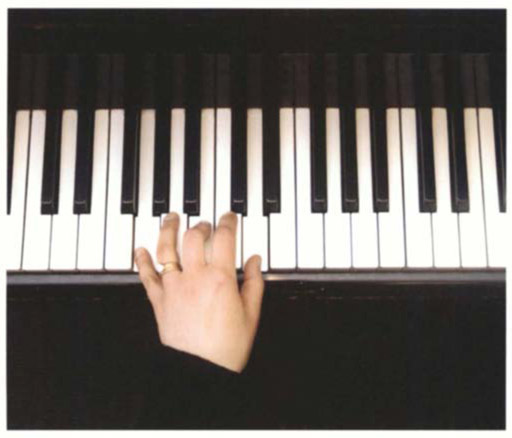
- The hand is over a G major five-finger pattern.
- Fingers 5-3-1 play the G major triad. Say the names of the keys in this triad, up and down: G-B-D-B-G.
- Since there are no black keys to play, keep the fingers slightly away from the black keys.
The major and minor five-finger patterns are useful for finding chords
What is a chord? It is simply three or more notes played at once. To our Western ears, chords built with intervals of 3rds sound great. The basics of chord building start with forming triads, or three-note/key chords. The chords for the patterns are played with every other key/note/finger (5-3-1 or 1-3-5). Visually on the keyboard this is pretty easy; visually on the staff, chords are easy to write and to see (line-note, line-note, line-note, or space-note, space-note, space-note); but technically, these chords are not easy to play. Be sure to work with one hand at a time.
G Major Blocked Chord

Chords are built up from a lower note, which is called the “root.” Choose a key, G for instance, and go up a 3rd to B, then up another 3rd to D. This last note is a 5th above the root. Go up another 3rd to F. This is a 7th above the root. A chord which has four different notes, a 3rd apart, is called a seventh chord.

You are not expected to play a seventh chord with one hand! If you want to hear the sound (and it’s a nice one), play two notes in each hand. Investigate the different sounds you can make with these seventh chords by playing on every key for one octave.
G Minor Blocked Chord
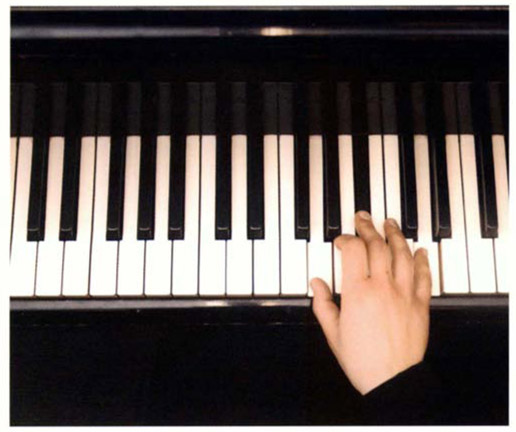
ZOOM
Chord patterns can be blocked (played simultaneously), or broken (played one note at a time). Listen to our National Anthem, which begins with a broken-chord passage. When a broken chord is extended to include the next chord up an octave (G-B-D, up to G-B-D), it is called an “arpegglo.” Try playing this chord hand over hand.
B Major Blocked Chord
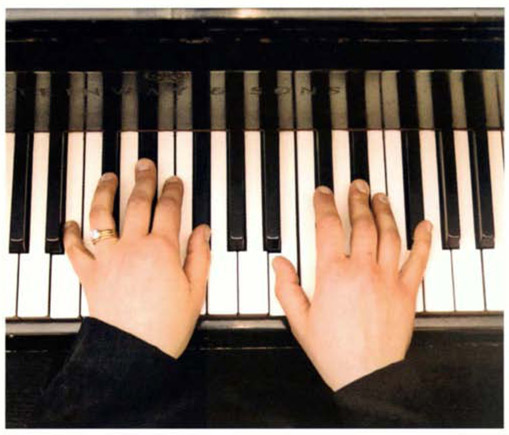
These translate to other chording instruments—guitar, accordion, organ, ukulele, mandolin
In a melody, intervals of 2nds refer to scale-like passages. Intervals of 3rds, 4ths, 5ths, and 6ths refer to chord-like passages. Recognizing these chordal passages helps in the reading of music.
In the lower part of the keyboard (or in the upper part if the melody is in the low section), or on stringed instruments like guitar and ukulele, chords add an accompaniment to a melody. The chords can be blocked (or “solid”), or they can be broken (or “arpeggiated”).
You can play a G major chord in the left hand to accompany the tune, “Are You Sleeping.” The melody begins on G, goes up a 2nd, up a 2nd, down a 3rd. Then it repeats the pattern. Practice that portion of the tune, and when it is easy, accompany it with the G major chord; play it on the word, “Are.”
Chords
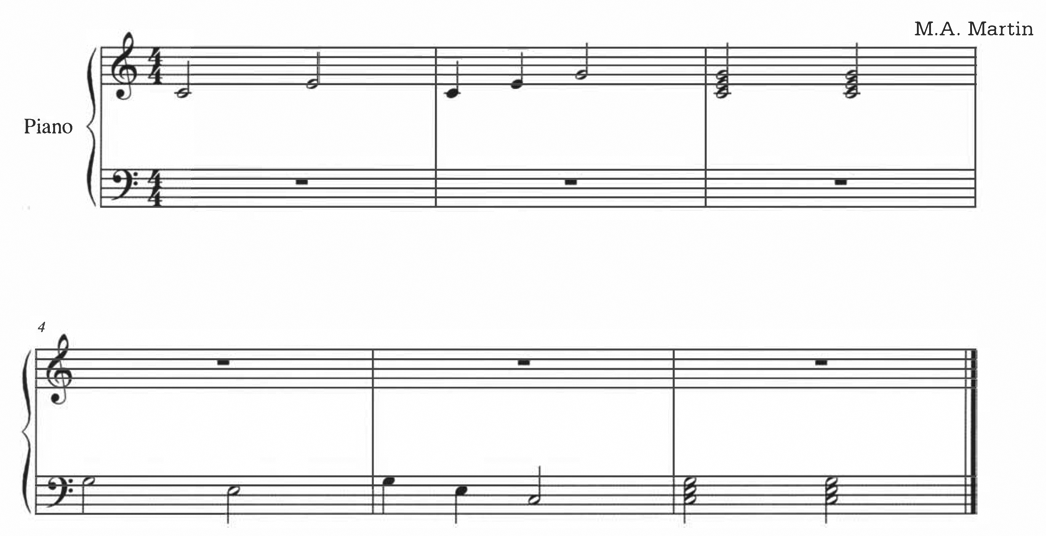
Track 26 
Now choose one particular chord, get both hands ready on it, an octave apart, and play it broken from the lowest note to the highest note. End with both hands playing the chord blocked. Try this with all the major chords you can play; then change each chord to minor. On another day, press the damper pedal and play the arpeggio. It makes a full and rich sound!
You can play “Oh, When the Saints” on a major chord position. Let’s use C major for our example. The tune begins by playing C up to E, then F to G. The intervals are up a 3rd, up a 2nd, up a 2nd. Repeat this phrase. Play it again a third time, but extend the phrase by playing down the chord to C, back up to E, down a 2nd to D. Can you “pick out” the rest of the tune? You don’t have to move out of the five-finger pattern.
Oh, When the Saints

Track 27 
To make a simple accompaniment, play 5ths and 6ths
The easiest accompaniment for a melody (assuming it is a simple, rather short melody) is a blocked 5th. This means that you can play “Are You Sleeping” again, but the left hand plays only the outside keys of the G major chord. It is easier to play, and in some cases sounds better. With this pattern, the tune goes, G-A-B-G, G-A-B-G, B-C-D, B-C-D.
Play the tune on the C major five-finger pattern—it feels the same but sounds either higher or lower. (C-D-E-C, C-D-E-C, E-F-G, E-F-G). The outside 5th in the left hand includes the notes C up to G.
Right Hand Plays a 6th
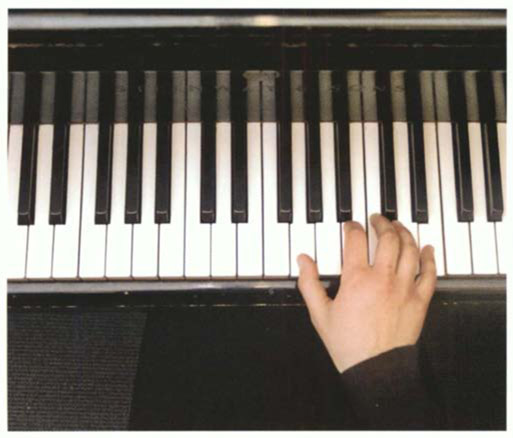
You can make the accompaniment more interesting by moving to the interval of a 6th. This involves moving the thumb up a whole step, or the fingers away from the thumb. Stay in the C major five-finger pattern for the melody; play “Ode to Joy” by Beethoven. Start on E in the right hand. The first phrase of the tune consists of 2nds only. Once you have the melody in your fingers, try accompanying with first a blocked 5th, then a 6th. Can you hear where to make the change from 5th to 6th?
Left Hand Plays a 6th
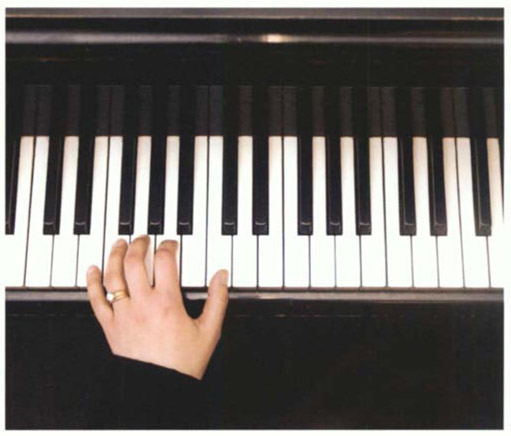
Change to the 6th by moving the thumb up; then play the 6th by moving the fingers away from the thumb. The 6th is made of either C up to A, or B up to G.
Which 6th sounds better with your melody?
Accompany each note of the five-finger pattern with either a 5th or a 6th. You need to play ultra slowly so you can manage the left hand accompaniment. When this is manageable, switch hands—five-finger pattern in the left hand, 5ths and 6ths in the right hand.
Ode to Joy

Track 28 
It can be easier to play a chord that has been inverted
The triads you have learned so far sound good, but sometimes inverting the chords makes a better sound, and might be easier to play. Learning to play triads in root position (the name of the chord is the lowest note), then playing an inversion, makes you feel at ease at the keyboard. Also, seeing the inversion on the staff in a blocked, then broken form, enables you to see chord patterns in any kind of music.
C Major Chord, First Inversion, LH
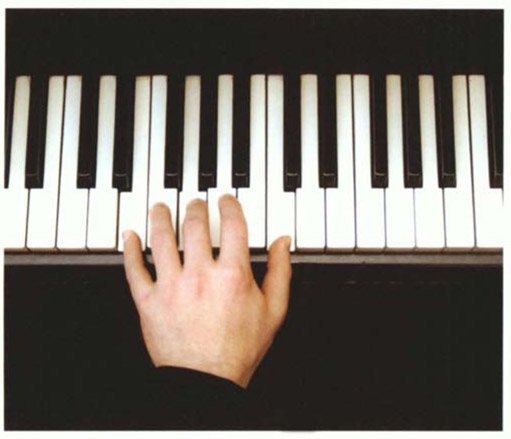
Since there are three different notes in a triad, there will be three positions of the chord. In the root position, the name of the chord will be the lowest note. The triad stacks up in intervals of 3rds.
Take the lowest note and make it the top note (up an octave from the low position). If your chord is a C major chord, the lowest note will now be E, the middle note G, and the highest note, C. The intervallic structure changed from all 3rds to a 3rd from the bottom key to the middle key, and a 4th from the middle key up to the highest key. The outside interval changed from a 5th to a 6th.
C Major Chord, First Inversion, RH
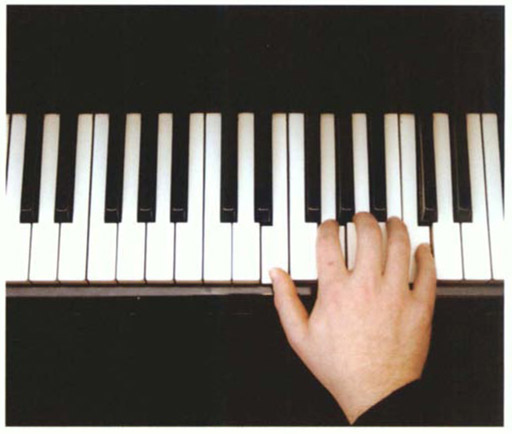
Again, take the lowest note, E, and move it to the top (up an octave). G is now the lowest key, C is in the middle, and E is the top key. The outside interval is a 6th.
You should practice these different positions of a chord, singing or saying the names of the keys as you play them. Play them in the left hand, then in the right hand.
C Major Chord, 1st Inversion
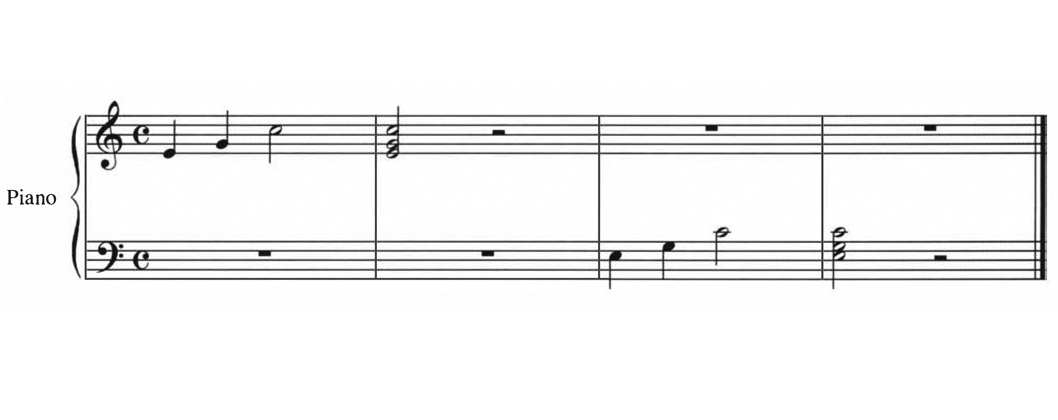
Track 29 
With this inversion, play all the bugle tunes you know
In this inversion, the intervals shift once again. The outside keys still form a 6th, but the 4th and the 3rd have switched places. The fingering in the left hand is now 5-2-1; in the right hand it is 1-3-5.
If you can hum, whistle, or simply hear bugle tunes, you should be able to pick out “Reveille,” “Taps,” or any other bugle tune, when your hand is on the second inversion. You will need the other hand to play a fourth key, which will be up a 3rd, or an octave above the lowest key in the inversion. If you go to baseball games, you can hear the organist play up the 2nd inversion, with that added octave at the top: G-C-E-G-E-G.
C Major Chord, Second Inversion, LH
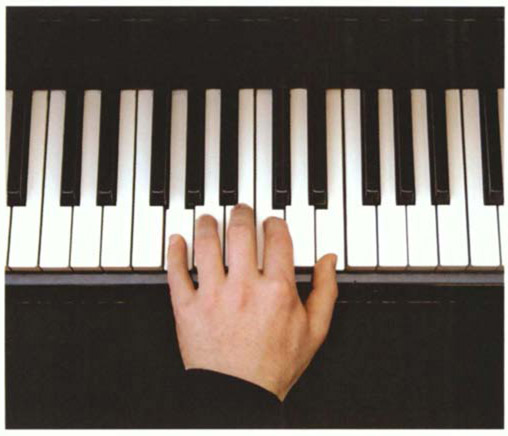
Using the 2nd inversion of the chord, you can also play the first phrase of ’Eine Kleine Nachtmusik” by Mozart. Begin with the middle note, C, and play down to G, back up to C, repeat three times and extend the phrase by playing up to E and the next G.
C Major Chord, Second Inversion, RH
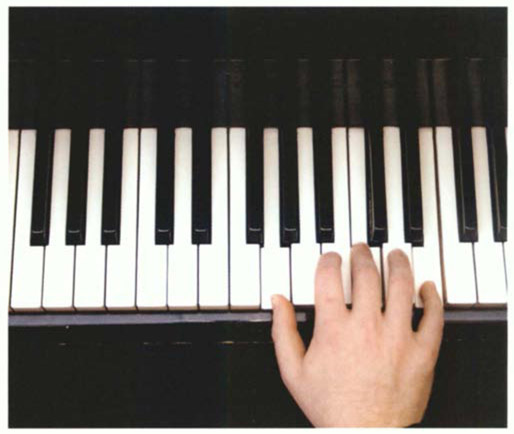
Once your mind and ear start working, you might hear lots of other tune fragments.
RED●LIGHT
I use the words “note” and “key” interchangeably. In the beginning it is important to differentiate between a key on the keyboard, and a note written on the music staff. Later on, as you learn scales, we will begin talking about a certain piece being “in the key of” C or G. To avoid confusion you should eventually stick with the word “note” for a key on the piano.
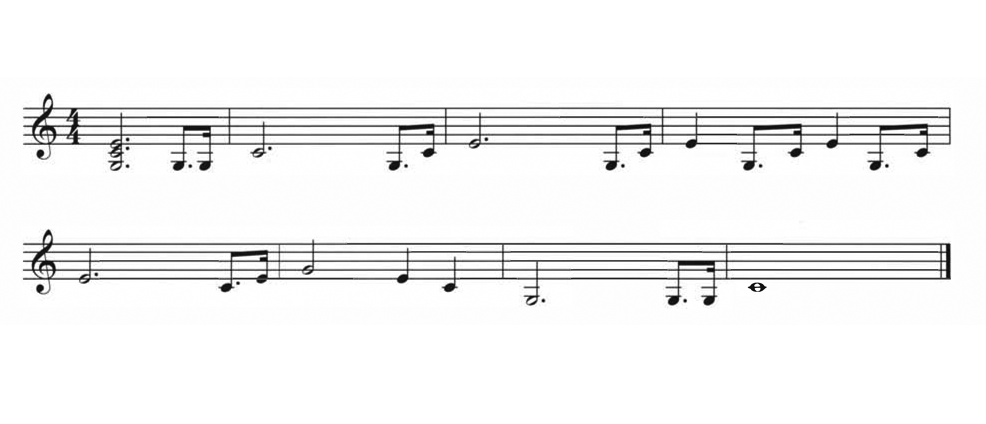
Track 30 
Having black keys in a chord makes it easy to find and feel the chord
Black keys once again help with finding your place on the keyboard! When you play the D major triad in root position, then invert the chord, you are able to feel the place. Experiment with fingering: When you play the first inversion of the D major triad in the left hand, finger 5 doesn’t always feel comfortable on F♯. Try playing the F♯ with finger 4, A with finger 2, and D with finger 1.
C Minor Chord, First Inversion, Both Hands
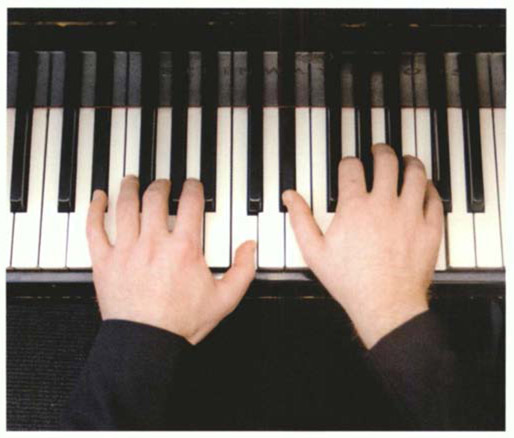
In the right hand, if the 5th finger is on a black key (F♯ in the D major chord), you can try the same fingering; i.e. finger 4 on F♯, finger 2 on D, finger 1 on A.
Personally, I like to use the thumb on all the chords, whether it plays a white key or a black key. You can try other fingerings, but don’t twist the hand or wrist to get the fingers in place. Move forward toward the fallboard. The goal is comfort and ease of movement.
C Minor Chord, Second Inversion, Both Hands
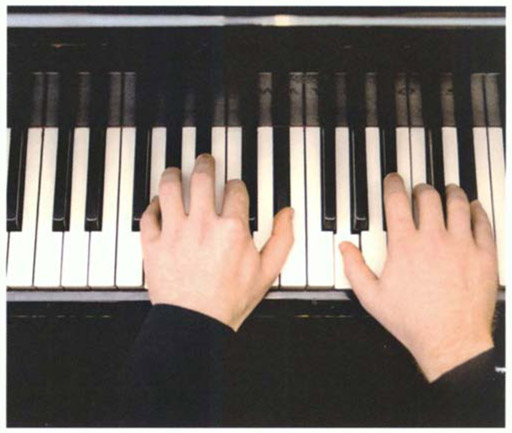
As with other chord practice, name the notes of the chord as you play them. Saying them aloud helps you to remember them. If you are having trouble playing the chords evenly (all three notes sounding at the same time), go back to the way you worked on each finger, then two-finger combinations. As the fingers gain strength you will be able to hear a difference in the evenness of the chords.
A Tune of Chord Notes
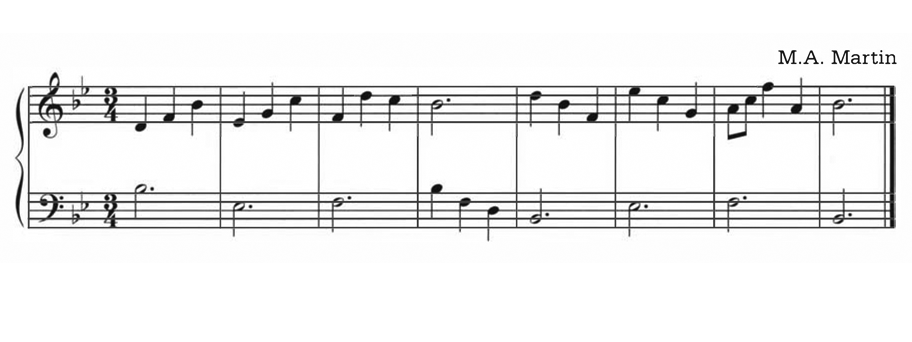
Track 31 